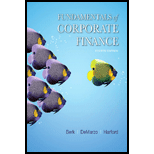
Ex-Dividend: A stock dividend is treated as ex-dividend when company confirms the person to receive the payment of dividend.
Record Date: The date on which company decides to pay the dividend to its shareholders is called as the record date.
To determine:
The ex-dividend date and its significance.
Explanation of Solution
The ex-dividend date is the date which is set two days before the record date. Any shareholder who buys the stock after ex-dividend date does not have any right to receive the dividend.
For example, if the record date of stock is 15 January 2018 then, its ex-dividend date will be two days before the record date that is 13 January 2018
The significance of ex-dividend date for the shareholders is:
- Investors who want to receive the dividend must purchase the stock three days before the record date.
- The ex-dividend date is set two days before the record date. Therefore, in order to receive the dividend investors need to have the stock one day before the ex-dividend date.
- If a shareholder buys the stock on the ex-dividend date then, that shareholder is not liable to receive the dividend.
Thus, a shareholder must purchase the stock one day before the ex-dividend date or three days before the record date to receive the dividend.
Want to see more full solutions like this?
Chapter 17 Solutions
Fundamentals of Corporate Finance (4th Edition) (Berk, DeMarzo & Harford, The Corporate Finance Series)
- The time value of money concept assumes that: A) A dollar today is worth more than a dollar tomorrow B) A dollar tomorrow is worth more than a dollar today C) Money has no time value D) Money grows at a fixed interest rate need answer.arrow_forwardThe time value of money concept assumes that: A) A dollar today is worth more than a dollar tomorrow B) A dollar tomorrow is worth more than a dollar today C) Money has no time value D) Money grows at a fixed interest ratearrow_forwardWhich option is correct? 19. In financial terms, liquidity refers to: A. Profitability of an investmentB. Ability to meet short-term obligationsC. Long-term solvencyD. Market value of equityarrow_forward
- The following data provides the monthly Comcast cable bill for a random sample of 20 households along with the number of televisions in the household (TV), the number of people living in the household (People), and the number of years that household has been a Comcast customer (Years). Bill TV People Years $56 1 3 8 $59 3 5 11 $67 3 2 3 $75 2 3 8 $76 4 1 8 $82 1 5 4 $84 3 3 3 $84 1 3 8 $84 4 4 4 $90 2 4 3 $91 3 5 5 $100 2 7 9 $100 2 2 5 $102 4 4 6 $104 3 5 10 $104 3 4 6 $112 4 3 2 $114 4 5 8 $130 5 5 1 $135 5 6 7 Develop a regression equation that will predict the monthly Comcast cable bill for a household based on the number of televisions in the household, the number of people living in the household, and the number of years that household has been a Comcast…arrow_forwardcan you provide correct answer for this question? If the Net Present Value (NPV) of a project is positive, it indicates: A. The project is unprofitableB. The project is financially viableC. The project has no riskD. The project will increase costsarrow_forwardI need correct answer for this question! If the Net Present Value (NPV) of a project is positive, it indicates: A. The project is unprofitableB. The project is financially viableC. The project has no riskD. The project will increase costsarrow_forward
- The market where new securities are issued and sold to investors is called: A. Secondary marketB. Money marketC. Primary marketD. Over-the-counter marketarrow_forwardA bond is trading at a premium when: A. Its coupon rate is equal to the yield to maturityB. Its market price is higher than its face valueC. Its market price is lower than its face valueD. It is issued by a well-rated companyarrow_forwardNeed help ! In financial terms, liquidity refers to: A. Profitability of an investmentB. Ability to meet short-term obligationsC. Long-term solvencyD. Market value of equity need answerarrow_forward
- In financial terms, liquidity refers to: A. Profitability of an investmentB. Ability to meet short-term obligationsC. Long-term solvencyD. Market value of equityarrow_forwardNeed help! Which type of risk cannot be eliminated through diversification? A. Market riskB. Credit riskC. Operational riskD. Unsystematic riskarrow_forwardWhich type of risk cannot be eliminated through diversification? A. Market riskB. Credit riskC. Operational riskD. Unsystematic riskarrow_forward
 Essentials Of InvestmentsFinanceISBN:9781260013924Author:Bodie, Zvi, Kane, Alex, MARCUS, Alan J.Publisher:Mcgraw-hill Education,
Essentials Of InvestmentsFinanceISBN:9781260013924Author:Bodie, Zvi, Kane, Alex, MARCUS, Alan J.Publisher:Mcgraw-hill Education,

 Foundations Of FinanceFinanceISBN:9780134897264Author:KEOWN, Arthur J., Martin, John D., PETTY, J. WilliamPublisher:Pearson,
Foundations Of FinanceFinanceISBN:9780134897264Author:KEOWN, Arthur J., Martin, John D., PETTY, J. WilliamPublisher:Pearson, Fundamentals of Financial Management (MindTap Cou...FinanceISBN:9781337395250Author:Eugene F. Brigham, Joel F. HoustonPublisher:Cengage Learning
Fundamentals of Financial Management (MindTap Cou...FinanceISBN:9781337395250Author:Eugene F. Brigham, Joel F. HoustonPublisher:Cengage Learning Corporate Finance (The Mcgraw-hill/Irwin Series i...FinanceISBN:9780077861759Author:Stephen A. Ross Franco Modigliani Professor of Financial Economics Professor, Randolph W Westerfield Robert R. Dockson Deans Chair in Bus. Admin., Jeffrey Jaffe, Bradford D Jordan ProfessorPublisher:McGraw-Hill Education
Corporate Finance (The Mcgraw-hill/Irwin Series i...FinanceISBN:9780077861759Author:Stephen A. Ross Franco Modigliani Professor of Financial Economics Professor, Randolph W Westerfield Robert R. Dockson Deans Chair in Bus. Admin., Jeffrey Jaffe, Bradford D Jordan ProfessorPublisher:McGraw-Hill Education





